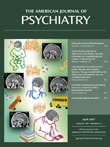To The Editor: Stephen Soumerai and Michael R. Law urge appropriate caution for antipsychotic formulary policy development, but their letter implicitly endorses maintenance of the current status quo. Second-generation antipsychotics have captured 90% of the market due, in part, to studies that used high-risk comparison treatments presented as broadly representing first-generation antipsychotics. Recent independent research undermines claims of their greater effectiveness and raises doubts that potential reduction of neurological side effects merits their greater cost and increased weight gain and metabolic risk.
The United States now spends twice as much as other industrial countries on health care and has poorer health status on many indicators. Policies that consider cost-effectiveness may allow improved outcomes at current costs. The Clinical Antipsychotic Trials of Intervention Effectiveness (CATIE) investigation and another comprehensive review
(1) suggest that the additional costs of second-generation antipsychotics may not be justified by their benefits, even after consideration of methodological limitations. Since some second-generation antipsychotics will soon be generic, the relevant policy question is less second-generation versus first-generation antipsychotics, but generic versus patent medicines. Better outcomes might be realized with increases in evidence-based psychosocial treatments and the use of patented drugs when specifically indicated, and generic antipsychotics otherwise.
It is suggested that the reach of formulary policy is limited to first-episode patients because others are “grandfathered in.” The mixed results of first-episode studies cannot be reviewed here, but CATIE showed that medication changes are common, and policies could encourage choices beyond the most expensive drugs. While almost everyone in CATIE who switched from perphenazine took second-generation antipsychotics, this was determined by the protocol. Of the perphenazine patients, 25% remained on this drug treatment for 18 months, which is equal or better than three of the second-generation antipsychotics, and 10% less than olanzapine, which had the greatest metabolic risk. Policies that have encouraged exclusive use of patent drugs do not optimally serve either patients or the public.
Tardive dyskinesia may yet be a benefit of second-generation antipsychotics over first-generation antipsychotics. The review that was cited
(2), however, is tentative, acknowledging that its results could have been biased because all three second-generation/first-generation antipsychotic trials used moderately high doses of haloperidol as the comparator and concluded only that “it would not appear premature for clinicians to consider these findings” (p. 414). The average median follow-up time of 8.8 months was not much longer than CATIE, which found no benefit for second-generation antipsychotics on a tardive dyskinesia measure. A meta-analysis of 31 trials found no greater risk of extrapyramidal symptoms between low potency first-generation antipsychotics and second-generation antipsychotics other than clozapine
(3) . The importance of CATIE is not that, by itself, it supports particular formulary policies, but that by offering independent information, it may stimulate development of better ones than are currently in place.
Several critical issues concerning our cost-effectiveness study were also raised in the editorial by Robert Freedman, M.D., et al.
(4) and deserve comment.
1.
Low follow-up rates/short duration. Although CATIE was longer than other second-generation antipsychotic trials, it achieved higher follow-up rates than most comparable studies, at equivalent time-points (e.g., 80% vs. 67% at 6 weeks)
(5,
6) . Four trials of second-generation versus first-generation antipsychotics included in a prominent tardive dyskinesia review
(7) averaged only 8.8 months median duration, which is roughly similar to CATIE, and included similarly chronically ill patients.
2. Tardive dyskinesia patients not randomized to perphenazine. The exclusion of tardive dyskinesia patients from randomization to perphenazine did not “limit randomness” because within the non-tardive dyskinesia stratum, patients had an equal chance of being assigned to each treatment.
While Dr. Freedman’s editorial credits second-generation antipsychotics generally with reducing prevalence of tardive dyskinesia, the review suggests that lower tardive dyskinesia risk for second-generation antipsychotics may only pertain to comparisons with high-potency first-generation antipsychotics at higher doses
(7) . Our article cites five recent studies that raise doubts about whether first-generation antipsychotics, especially lower potency first-generation antipsychotics such as perphenazine, have any substantially greater risk for either extrapyramidal symptoms or tardive dyskinesia than second-generation antipsychotics. We know of no epidemiological evidence that tardive dyskinesia has declined recently, but an equally plausible explanation would be that clinicians abandoned “mega-dose” strategies that were popular during the late 1970s and 1980s.
3. Use of intention-to-treat analysis. The comparison of costs and outcomes using all data conforms to established intention-to-treat principles for clinical trials. Randomized trials are designed to allow comparison of unbiased treatment groups. Failure to collect data after medication changes or exclusion of postrandomization data reduces confidence that the groups are unbiased. A secondary “as-treated” analysis replicated the original “no difference” CATIE results.
4. Quality-adjusted life year ratings. The “no difference” findings on quality-adjusted life year ratings cannot be attributed to insensitivity of this measure, since the results were essentially the same as those on the Positive and Negative Syndrome Scale; the Lehman, Heinrichs-Carpenter, and Visual Analogue measures of quality of life; employment; and neurocognitive assessments. Neither quality-adjusted life year ratings nor any other outcome measure showed significantly greater benefit for any second-generation antipsychotics than for perphenazine.
5.
Results from independent trials. Disappointment is understandable when results from new and methodologically strengthened studies contradict those of previous studies stimulating hope that second-generation antipsychotics would bring more cost-effective treatment to people with schizophrenia. A recent review of pre-CATIE research does not support this hope
(8) .
Many of the influential second-generation antipsychotics trials in which the results are now in question were primarily designed and authored by employees of the drug manufacturers whose products they evaluated. The results of CATIE are consistent with studies of commercial biomedical research
(9,
10) that find independent studies less likely to result in unwarranted favorable conclusions.

